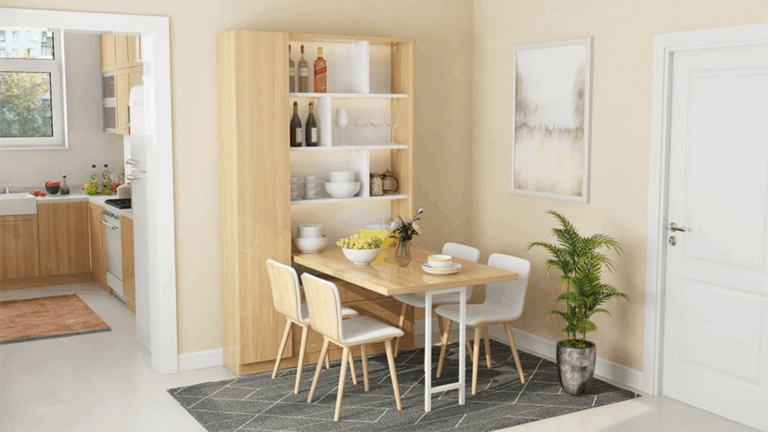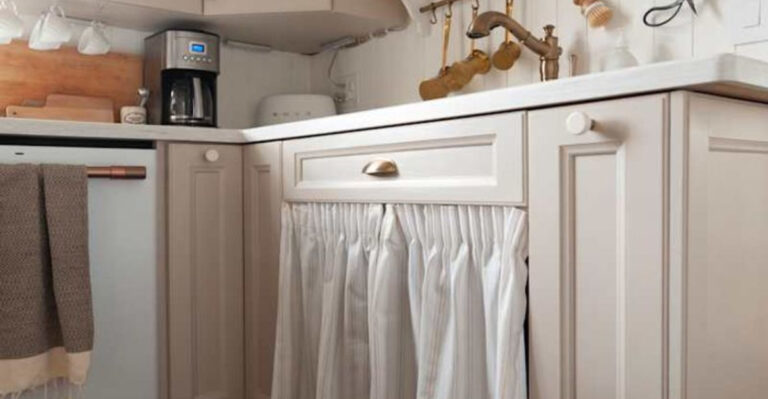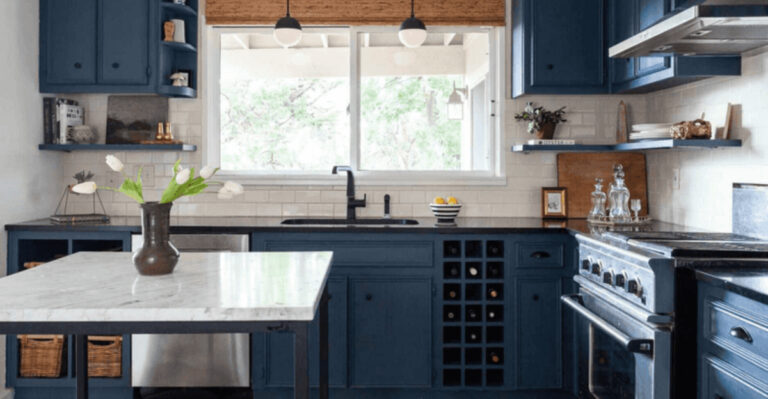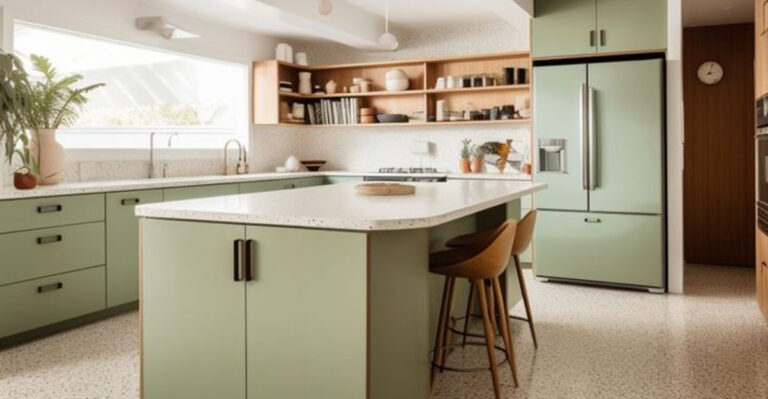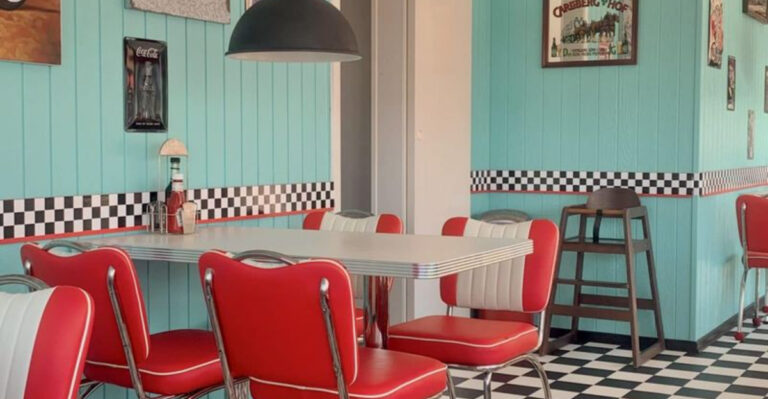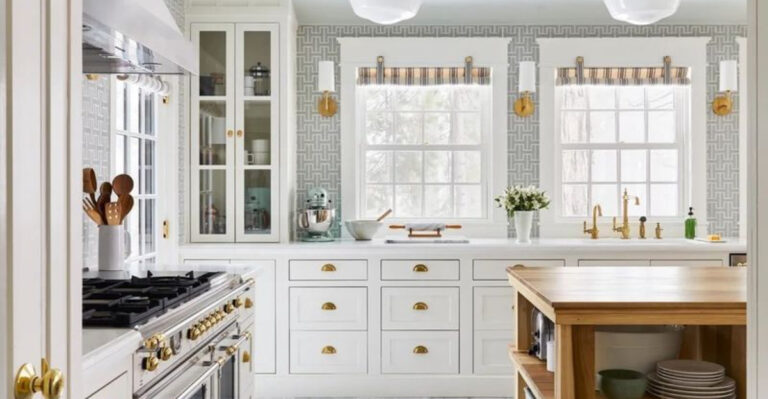18 Open Shelf Styling Secrets For A Modern Kitchen
I used to think kitchen shelves were just for storage, until I discovered the magic of open shelving. Suddenly, my everyday dishes became part of the decor, and my kitchen felt brighter and more personal.
There’s something so satisfying about turning your favorite mugs, bowls, and cookbooks into a curated display that’s both stylish and functional.
If your shelves currently feel more chaotic than chic, don’t worry. With a few simple tweaks, you can totally transform them into something out of a magazine.
1. Color Coordinate Like A Pro

Arranging items by color creates an eye-catching rainbow effect that instantly elevates your shelves. Start with whites and neutrals, then gradually move through the color spectrum.
Group similar hues together rather than scattering them randomly. Your kitchen will look intentionally designed rather than accidentally assembled.
For a cohesive look, pick colors that complement your kitchen’s existing palette—but don’t be afraid to add a pop of unexpected color for visual interest!
2. Mix Heights For Dynamic Display
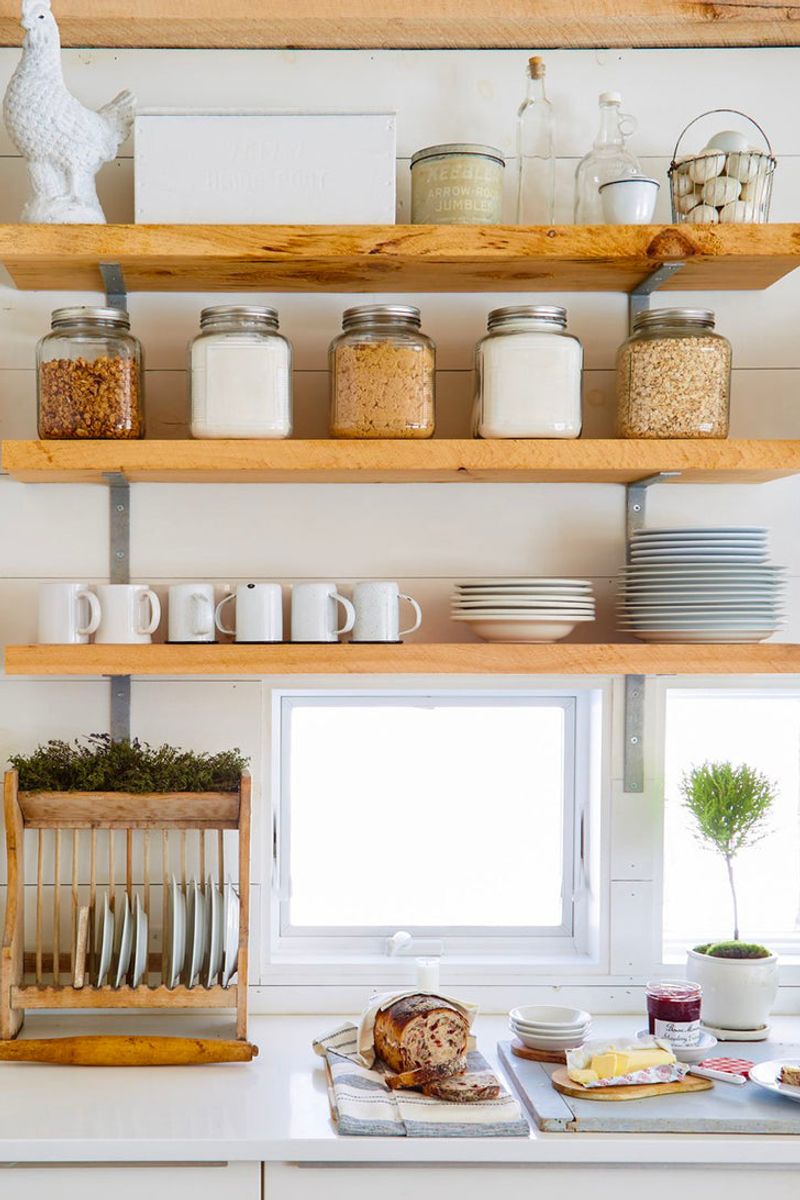
Varying the heights of your displayed items prevents the dreaded ‘flat line’ effect that makes shelves look boring. Tall pitchers can stand proudly next to medium-sized canisters and shorter cups.
Think of your shelf as a city skyline, some skyscrapers, some mid-rises, some townhouses. This creates natural rhythm and draws the eye across the entire display.
When everything’s the same height, nothing stands out. But with thoughtful height variation, each piece gets its moment to shine!
3. Incorporate Living Elements
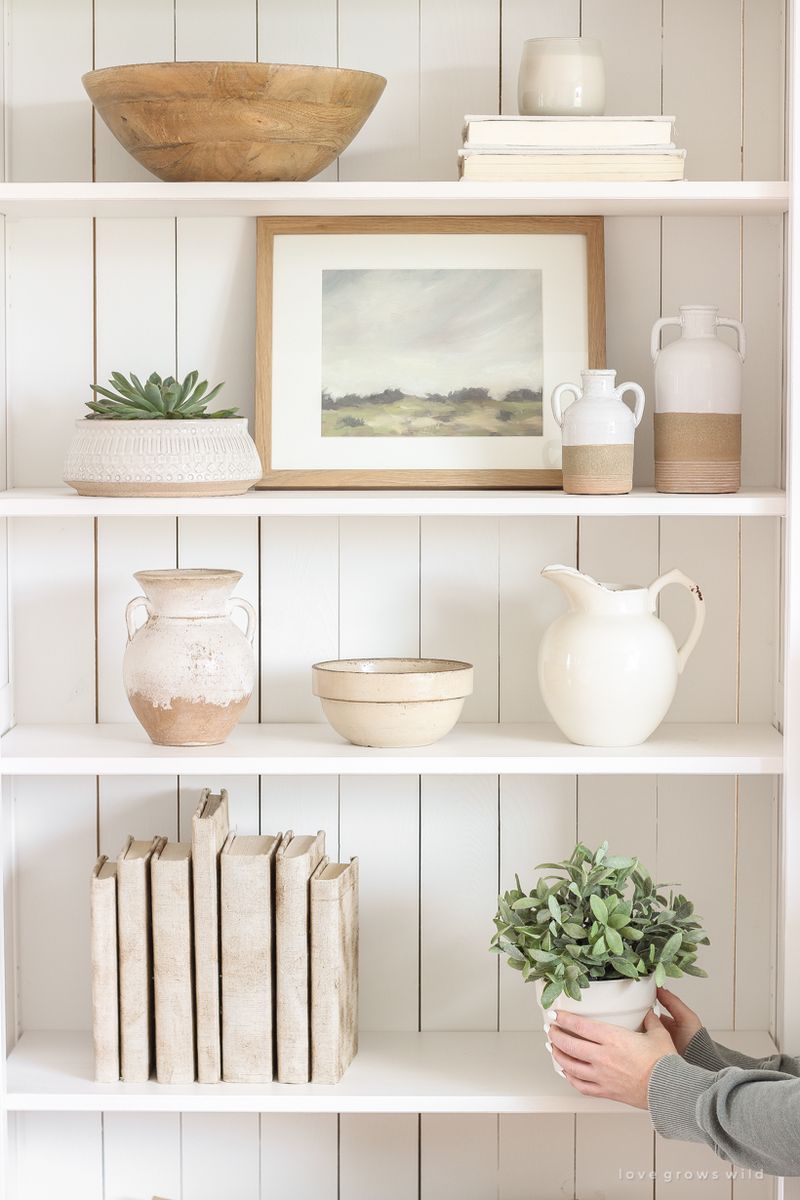
Plants breathe life into kitchen shelving, literally! Small potted herbs not only look gorgeous but serve a practical purpose when cooking.
Choose low-maintenance varieties like succulents if you’re worried about keeping them alive. Even artificial plants can add that needed touch of green without the upkeep.
Place plants at different heights and positions, maybe a trailing ivy from the top shelf or a compact basil plant nestled between cookbooks. The natural shapes soften the hard lines of dishware and containers.
4. Create Breathing Room
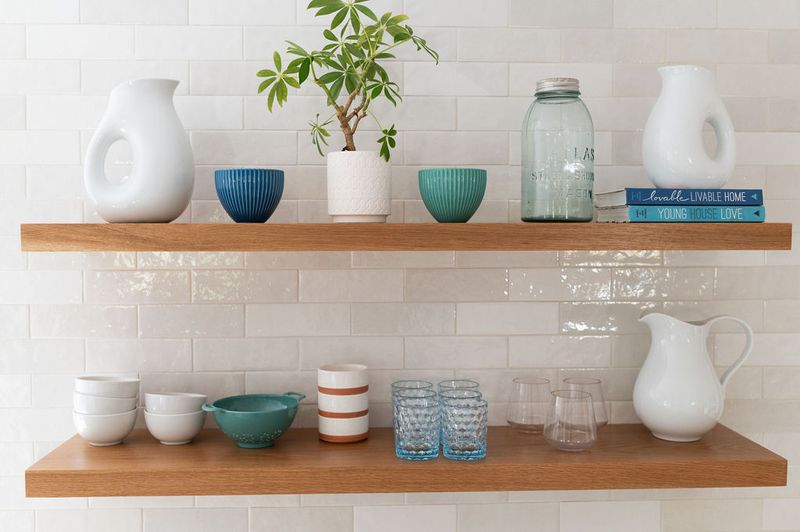
Overcrowded shelves scream stress! Your beautiful items need space to be appreciated, just like artwork in a gallery.
Leave at least 20% of your shelf space completely empty. This negative space creates visual breaks that allow the eye to rest and appreciate each grouping of items.
If you’re struggling to create this space, it’s probably time to be more selective about what earns a spot on your open shelves. Remember: not everything deserves to be displayed!
5. Group Items In Odd Numbers
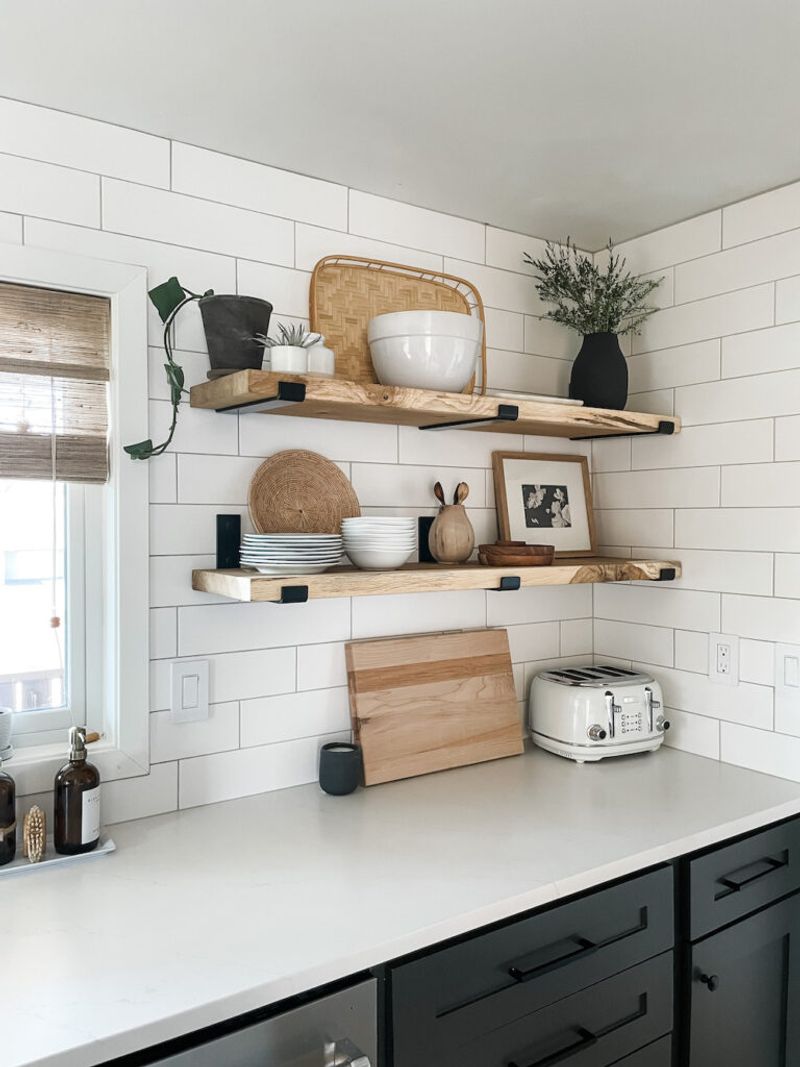
Strange but true, our brains find groupings of three, five, or seven more visually appealing than even numbers! Try arranging three graduated canisters or five cookbooks together.
Odd-numbered groupings create more interesting shapes and asymmetry that keeps the eye engaged. Even professional stylists swear by this simple trick.
For maximum impact, group similar items together, three white pitchers of different sizes or five wooden utensils, to create a cohesive collection that still has visual variety.
6. Layer Items For Depth
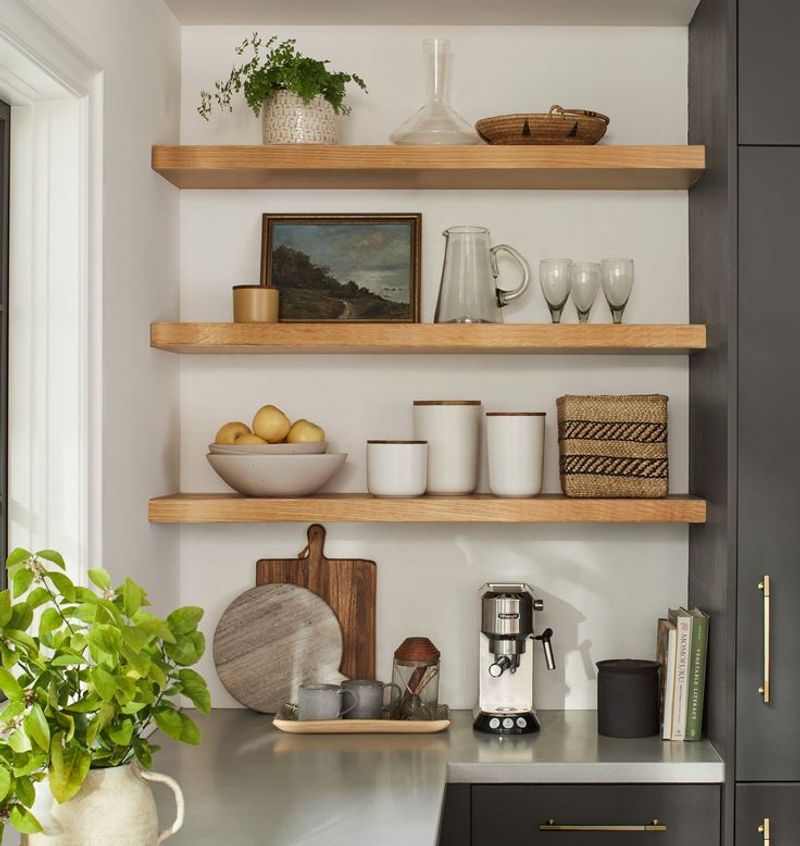
Flat arrangements make shelves look two-dimensional and boring. Create depth by placing some items slightly in front of others, like staging a tiny theater production!
Lean cutting boards or decorative plates against the back wall, then position smaller items in front. This simple layering trick adds incredible dimension to your display.
Just be careful not to create precarious arrangements that might topple. Safety first, especially in busy kitchens where items get grabbed frequently!
7. Balance Practical With Decorative
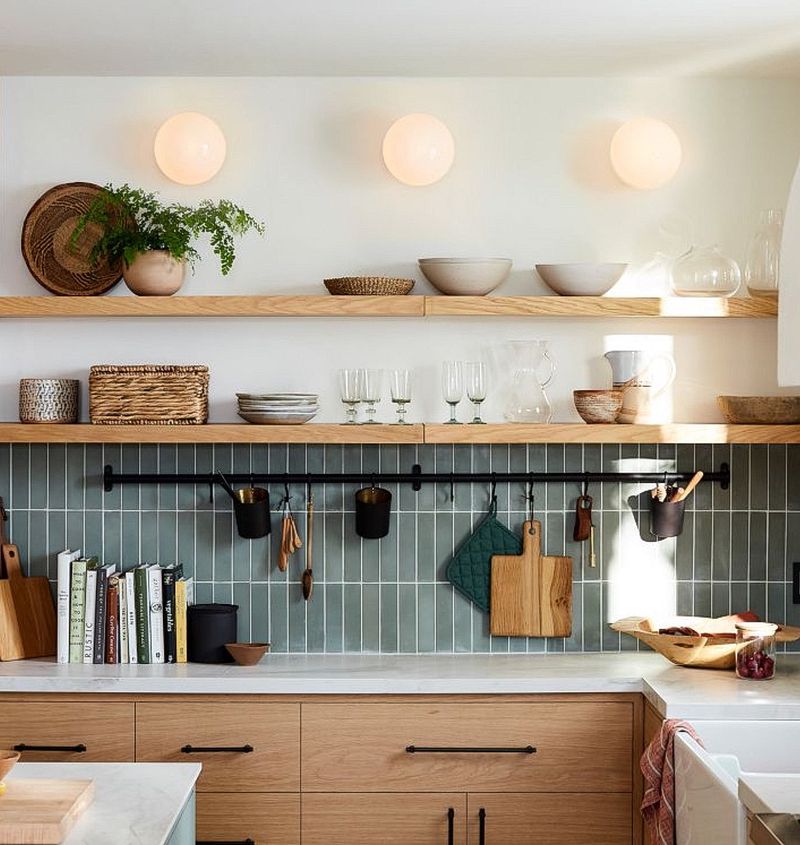
Finding the sweet spot between function and beauty makes open shelving truly shine. Mix everyday items you actually use with a few purely decorative pieces.
Place frequently-used dishes on lower, easy-to-reach shelves. Save higher shelves for decorative items or less-used special occasion pieces.
Good rule of thumb: aim for 70% practical items and 30% decorative objects. This ratio ensures your shelves remain useful while still looking intentionally styled rather than merely utilitarian.
8. Showcase Collections Thoughtfully
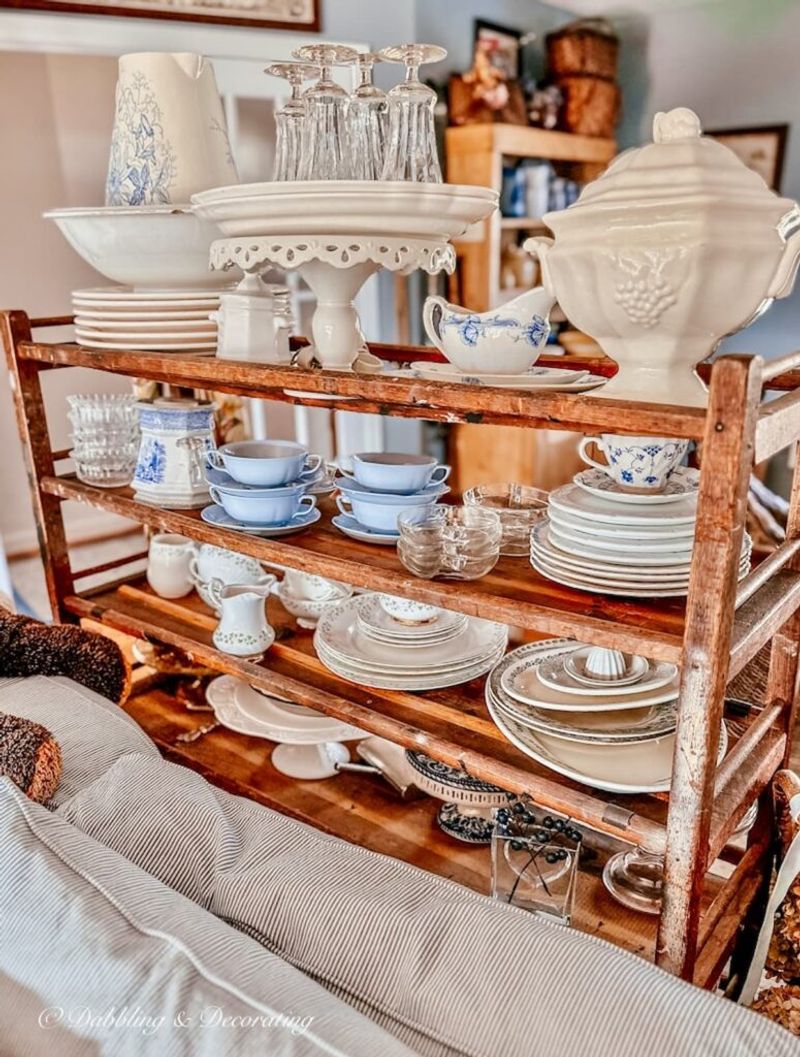
Collections make powerful statements when displayed cohesively rather than scattered throughout. Your vintage teacup collection looks much more impressive grouped together than spread across multiple shelves.
Arrange collections by size, color, or era for added visual impact. Even ordinary items like drinking glasses become striking when presented as a deliberate collection.
Just remember that less is often more, displaying your twelve best pieces might create more impact than crowding in all thirty!
9. Incorporate Texture Contrasts
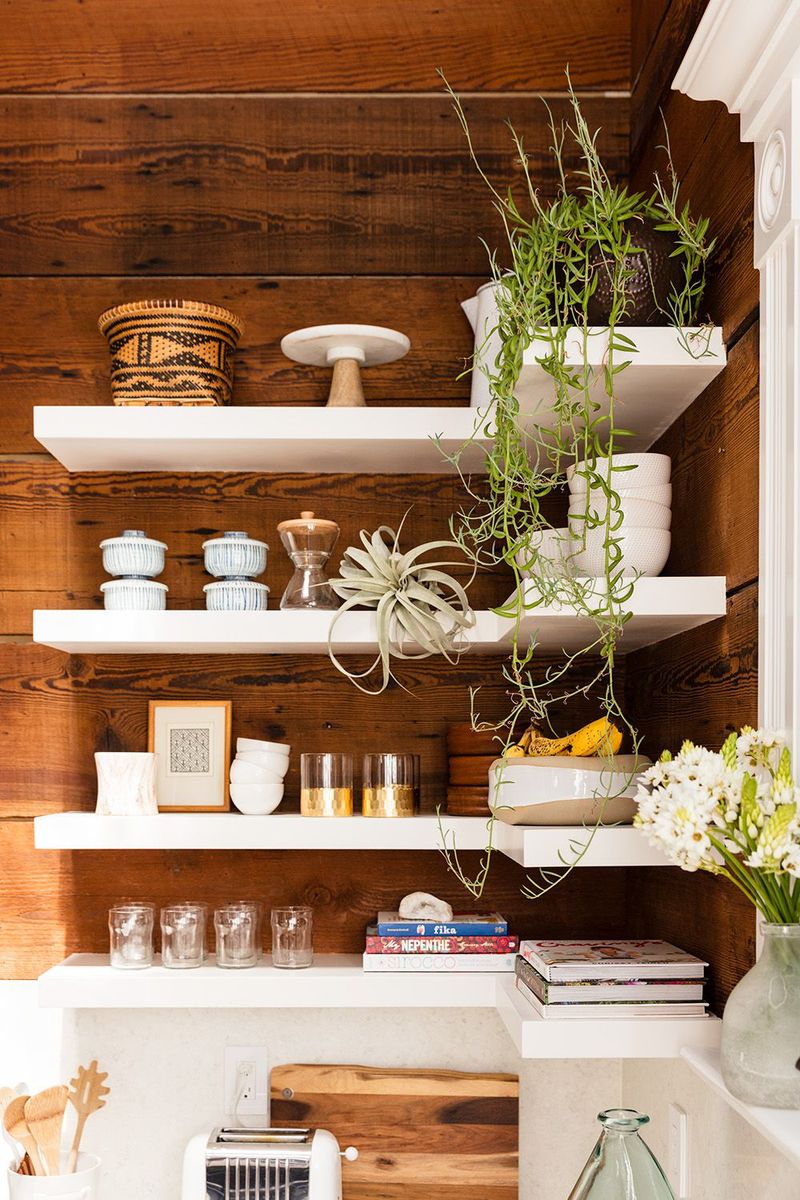
Kitchens often feature hard, shiny surfaces like glass, ceramic, and metal. Adding contrasting textures creates visual interest and warmth.
Mix smooth ceramic plates with woven baskets, rough wooden cutting boards, and textured linens. These tactile differences make shelves more inviting and dimensional.
For maximum impact, place contrasting textures next to each other, position a smooth glass pitcher beside a rough woven bread basket, or lean a wooden board behind glossy white plates.
10. Use Books As Functional Decor
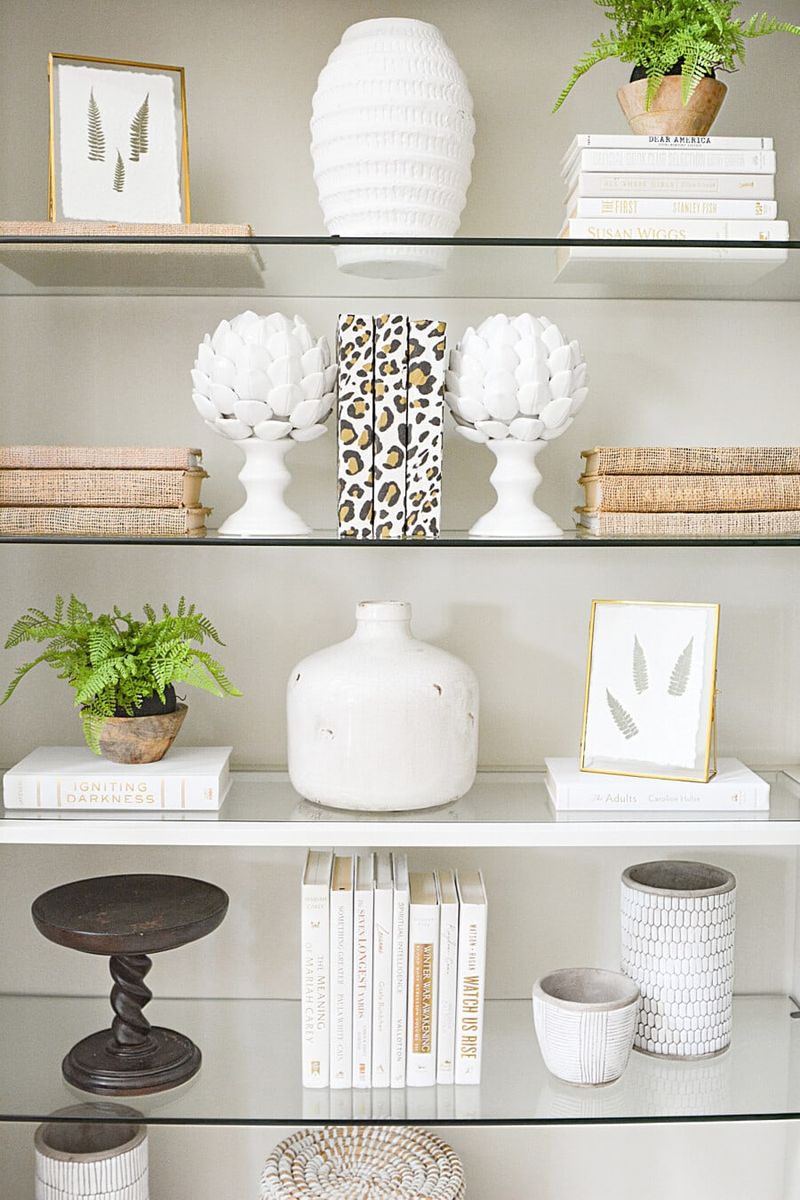
Cookbooks aren’t just for reference, they’re colorful design elements! Stand some upright with bookends and lay others flat as platforms for smaller items.
Choose cookbooks with beautiful spines or covers that complement your color scheme. You can even remove dust jackets to reveal more attractive hardcovers underneath.
For a cohesive look, limit your shelf selection to cookbooks you actually use or that have special meaning, rather than displaying every cookbook you own.
11. Create Visual Anchors
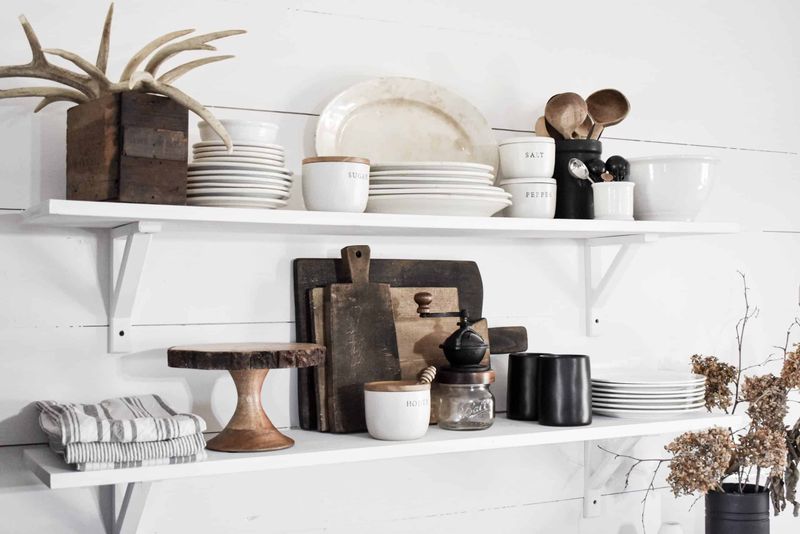
Every well-styled shelf needs a few standout pieces that draw the eye and anchor the arrangement. These statement items provide focal points around which other elements can be organized.
Look for pieces with unusual shapes, bold colors, or larger sizes to serve as anchors. A beautiful turquoise pitcher or an oversized wooden bowl can do the trick.
Position these anchor pieces strategically, ideally at different points across your shelving to create balanced focal points that guide the eye through the entire display.
12. Embrace Negative Space
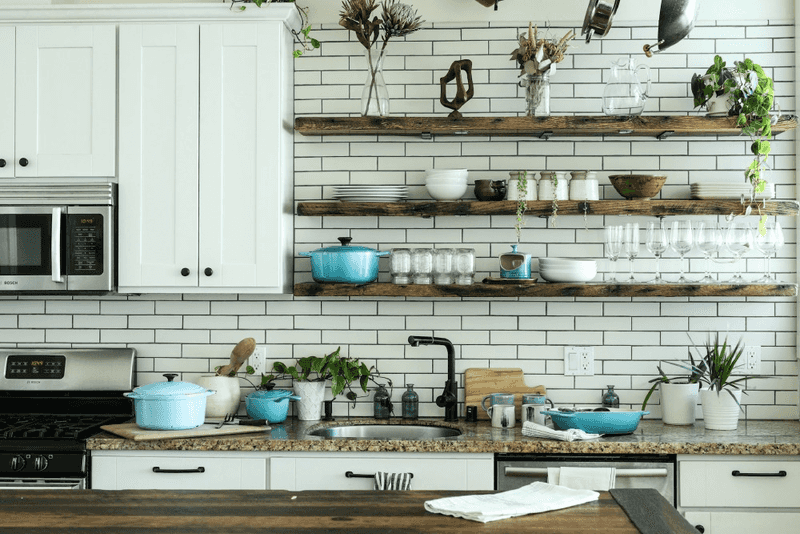
Sometimes what you don’t display is as important as what you do! Resist the urge to fill every inch of shelf space, emptiness creates visual breathing room.
Strategically placed gaps between groupings help define distinct collections and prevent visual overwhelm. Think of these empty spaces as punctuation marks in your shelf’s visual story.
If you’re naturally a maximalist, try removing one item from each shelf. You’ll be surprised how much more impactful your display becomes when each remaining piece has room to be appreciated!
13. Rotate Seasonal Elements
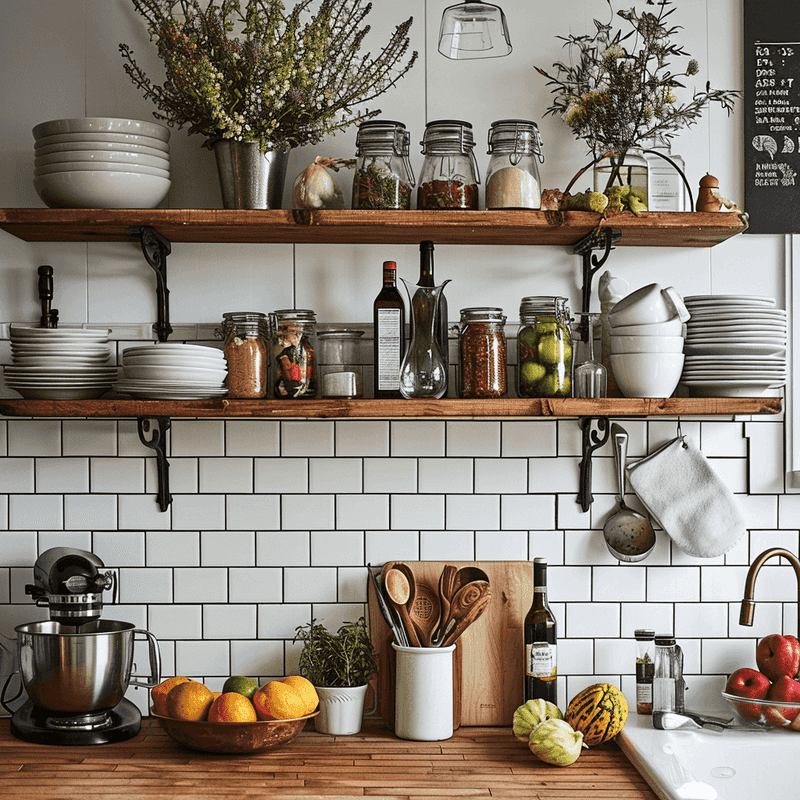
Keep your kitchen shelves feeling fresh by incorporating seasonal elements that change throughout the year. Summer might feature colorful fruit bowls and bright linens.
Winter could showcase cozy elements like copper mugs for hot drinks and evergreen sprigs in small vases. These simple seasonal touches prevent shelf displays from becoming stagnant.
Bonus: rotating items periodically gives you a natural opportunity to dust and clean your shelves, keeping everything looking its best!
14. Play With Repetition
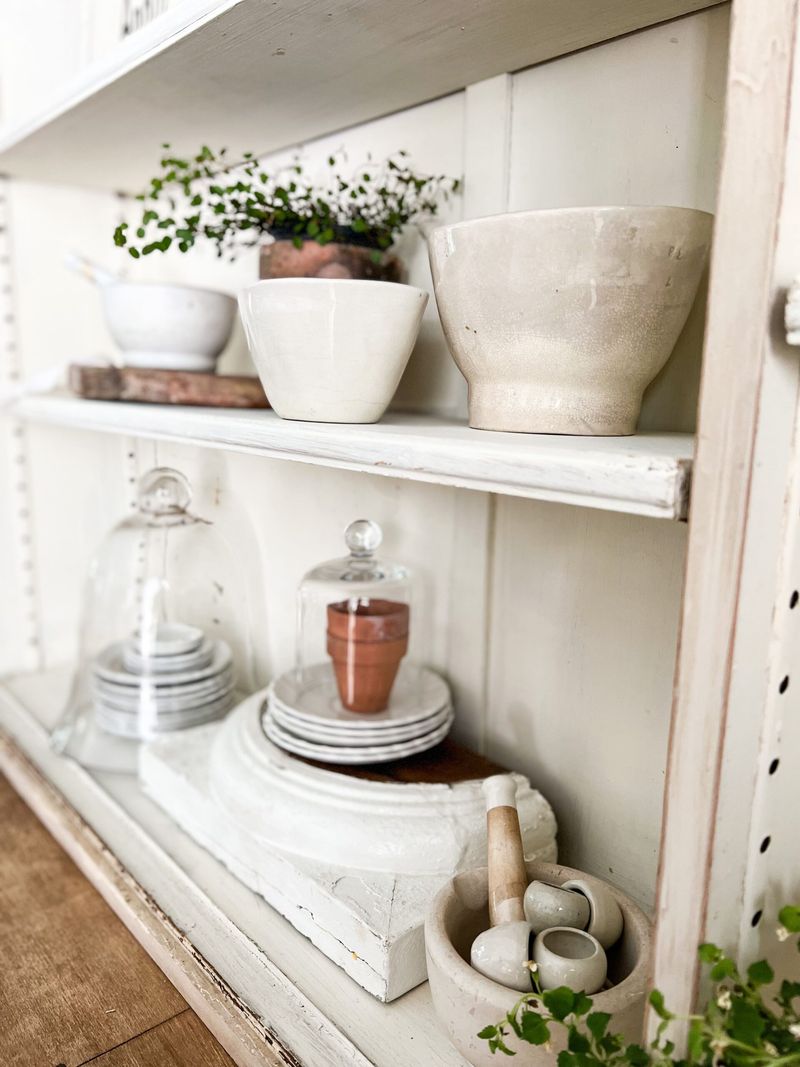
Repeating similar items creates rhythm and intentionality in your display. Line up a row of identical glasses or a collection of white pitchers in graduating sizes.
This simple technique instantly communicates that your shelves are thoughtfully designed rather than randomly assembled. Even everyday items look special when arranged in deliberate repetition.
For maximum impact, try repeating just one element, like color or shape, while varying others. Six mugs in different shapes but all in shades of blue create cohesion without monotony.
15. Incorporate Metallic Accents
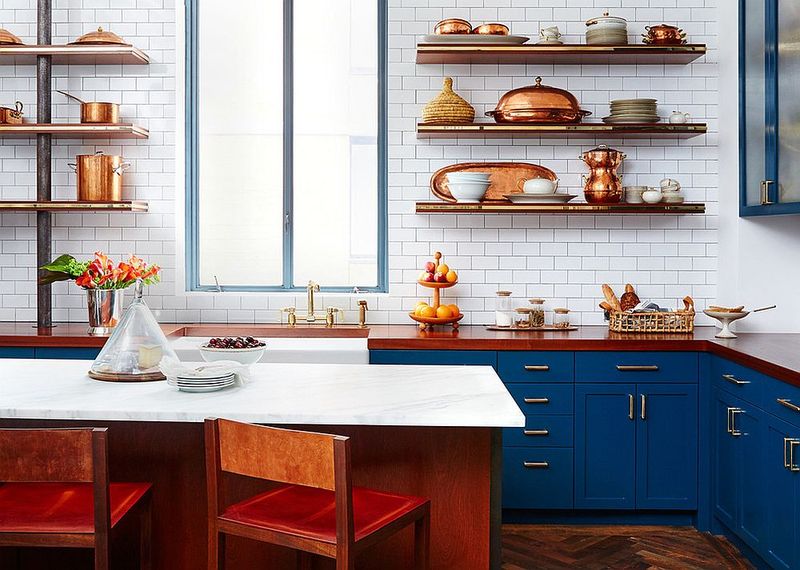
Metallic elements add instant sophistication and light-reflecting properties to kitchen shelves. Copper Moscow mule mugs, brass candlesticks, or silver picture frames catch the light beautifully.
Mix metallic finishes for a collected, evolved look, unless your kitchen already has prominent fixtures in a specific metal, in which case matching might create more harmony.
Keep metallics spread throughout your shelving rather than concentrated in one area. This distributes the light-catching properties evenly and prevents any section from feeling too heavy or dominant.
16. Consider The Background
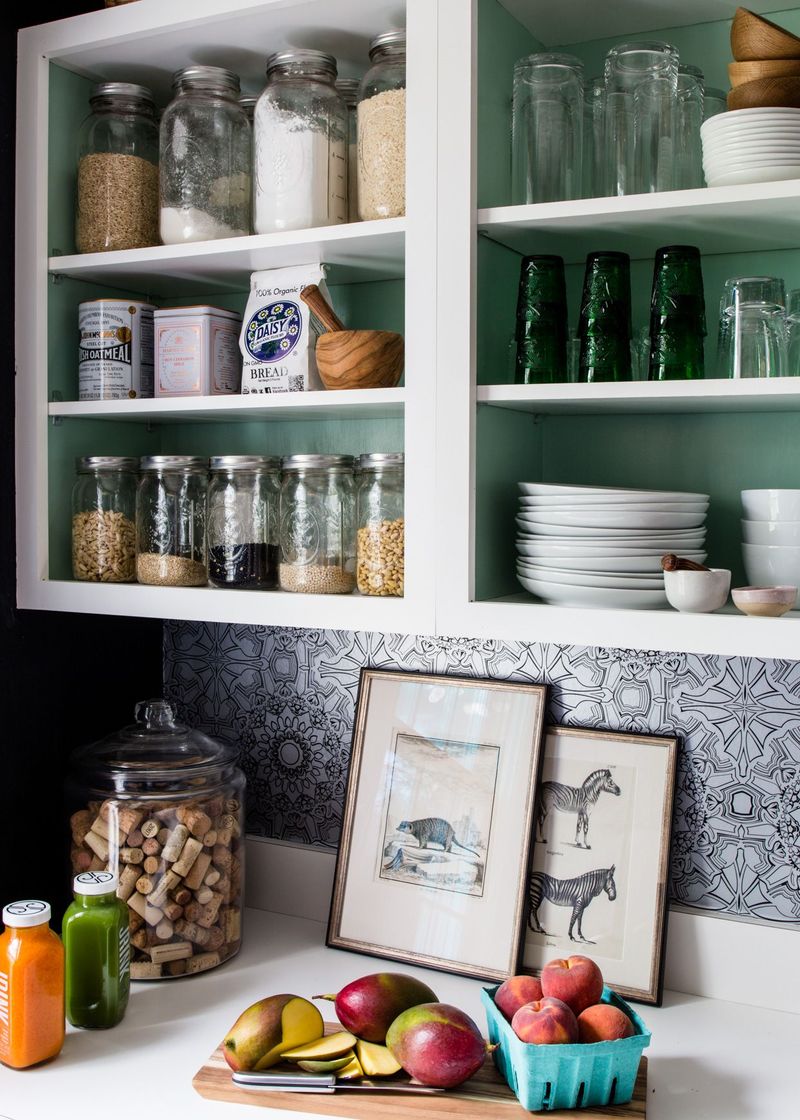
Your shelf’s backdrop dramatically impacts how displayed items appear! White or light backgrounds make colorful items pop, while darker backgrounds create drama and sophistication.
If you’re feeling adventurous, try painting the back wall of your shelves in a contrasting color or applying removable wallpaper. This instantly elevates the entire display.
Even adding simple beadboard or shiplap to the back of shelves creates texture that makes everyday items look more special against this thoughtful backdrop.
17. Light It Up Strategically
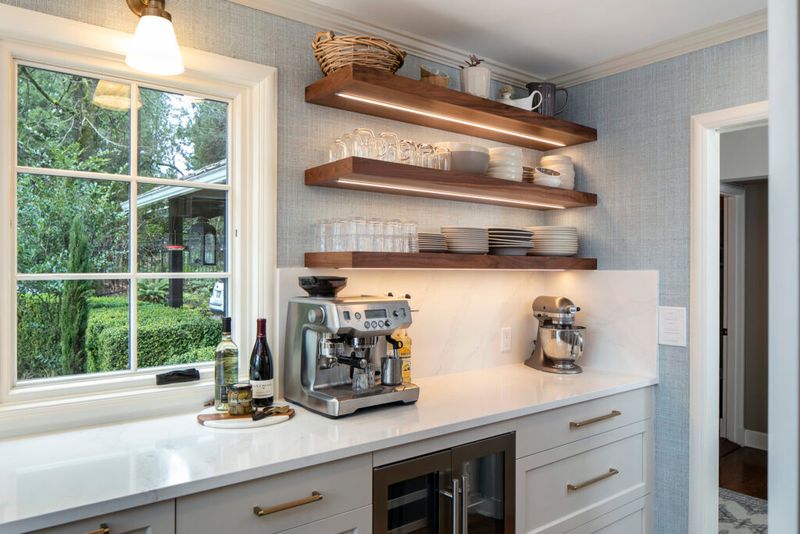
Lighting transforms ordinary shelves into showstopping displays! Under-cabinet LED strips or small puck lights installed above shelves create dramatic shadows and highlights.
Glass and metallic objects particularly benefit from strategic lighting, as they reflect and amplify the light. Position these items where they’ll catch the illumination for maximum sparkle.
Even without installed lighting, consider how natural light hits your shelves throughout the day, and position your most beautiful objects where they’ll be highlighted by sunlight streaming through windows.
18. Add Unexpected Art Elements

Who says art belongs only in living rooms? Small framed prints, vintage postcards, or even beautiful recipe cards can add personality to kitchen shelving.
Lean small artwork against the back of shelves rather than hanging it for a casual, collected feel. This approach allows you to rotate art easily without making holes in your walls.
For a cohesive look, choose art with colors that complement your kitchen palette and themes that relate to food, cooking, or meaningful locations.


